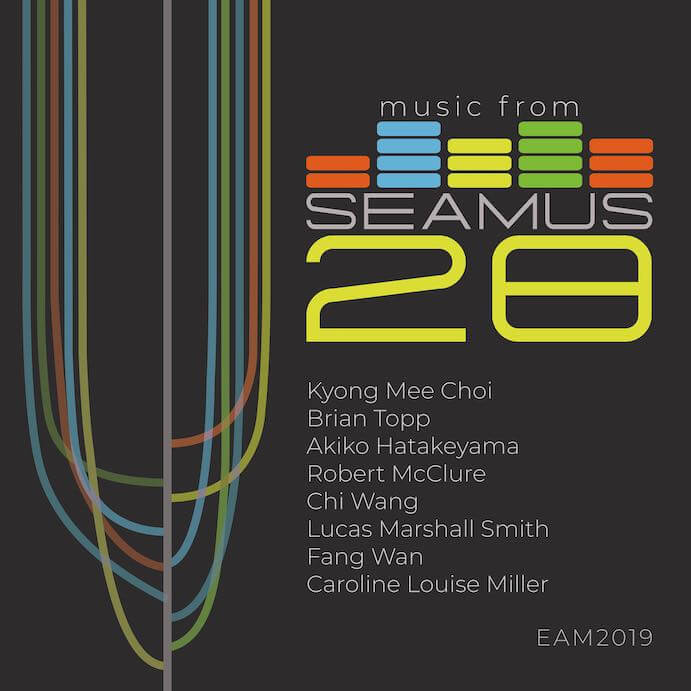The festival compilation is an album format especially particular to the New Music community; an institution gathers representative pieces from a recurring gathering, highlighting the work they curate. Among these, a prominent US-based compilation is the annual release by the Society for Electro-Acoustic Music in the United States (SEAMUS). Music from SEAMUS presents an aesthetically representative selection of pieces from their festival—SEAMUS vol 28, released on New Focus Recordings and produced by Scott Miller, includes pieces from their 2018 national conference at the University of Oregon.
It’s an interesting object through which to consider strands of contemporary electronic composition: the format is all audio (which belies the significance of live presentation), the pieces largely comprise a shared aesthetic, and the works scatter across the spectrum of structural success. There is something on this album for everyone, including an opportunity to reflect on the breadth and limits of electro-acoustic composition.
The release opens with Train of Thoughts, a fixed-media track by Kyong Mee Choi. The piece is a beautifully orchestrated display of close listening, deftly arranging train whistles, twinkling bells, ripping samples, and synthesizers. The space created by these sonic combinations is entrancing throughout, but the piece suffers from structural issues as the second half simmers into a relatively placid close.
Kyong Mee Choi
Formal construction affects a number of pieces on the album. Robert McClure’s in excess falters under the same developmental issues as Choi. His attention to sonic manipulation of sources is assured: samples of strained plastic flit across the stereo field over bristling harmony. Still, the convincing first half gives way to a conclusion that seems to trace a form without truly engaging it. Electro-acoustic composition puts unique primacy on detailed manipulation of sounds themselves, and all three pieces demonstrate mastery in this regard; more formal balance would have made them unquestionable successes.
Brian Topp‘s energetic Ljós for saxophone and electronics faces the inverse problem as Choi’s. The opening blur of augmented instrumental/electronic gestures sounds disjunct and oversaturated with reverb, but brilliantly threads into a satisfying climax. Topp mines the sonic commonalities of sampled voice and live saxophone with careful consideration, and saxophonist Justin Massey assuredly delivers the performance.
The standout of the compilation is Akiko Hatakeyama’sち – chi. A lush drone slowly develops into a bed of tones, supporting Hatakeyama’s mournful vocalizations. This patient soundscape would be satisfying enough, but what truly makes the piece is its performance. The drones are all generated by sensors measuring luminescence of candles that Hatakeyama lights and moves with ritualistic purpose, her voice affecting the jittering flames and thus ensuring constant undulation in the drone. The total affect is a simple, wholly unified, and assured work. Sadly, the visual is not part of SEAMUS’s release and must be found on her website.
This reliance on aural presentation seems to be a limitation of SEAMUS’s assumed format; a later track, Chi Wang’s Peony Garden, also has a significant visual component as Wang manipulates four suspended Wii controllers to advance a fractured adaptation of a traditional Kunqu opera. While Hatakeyama’s piece holds up despite the missing information, the interactivity of Wang’s performance adds a dramatic element absent in the music alone. The chattering voices and desolate chimes engross the listener in the context of a visual performance; otherwise, the sounds grow tiresome.
Lucas Marshall Smith’s In His Hands provides a welcome departure from the homogenous “SEAMUS house style” of previous pieces. Extended vocalizations, hymnody, and menacing electronic growls augment his recitation of an 18th century Jonathan Edwards sermon. Unfortunately, ineffective dramaturgy weakens the piece. Smith’s approach to the desired commentary feels heavy-handed, making little developmental use of the sonic palette at his disposal and leaving no room for reflection. That said, Smith’s approach to composition stands out for its bold theatricality and is a voice (literally) to pay attention to.
The penultimate track, Fang Wan’s Origin, moves back to the brooding synth/sample textures of earlier pieces. Combining Wacom tablet and Kyma software, Origin is a meditative combination of filter drones and percussive hits. More than anything, Origin suffers from track listing; after so many pieces of bell flickers and atmospheric rumbles, Wan’s piece feels lost amidst the compilation and betrays the limits of SEAMUS’s aesthetic reach.
Caroline Louise Miller–Photo by Lyndsay Bloom
President Ted Coffey acknowledged this constraint at the 2019 awards banquet—hopefully SEAMUS will reconsider how it interfaces with more diverse practices and practitioners. Fortunately, the last track offers a potential glimpse of this direction. Caroline Louise Miller’s Subsong combines many of the album’s familiar sounds—vocalizations, erratic clicks, sampled recordings—and invigorates them with a beat. It’s not a four-to-the-floor banger, but a groove haunts the track in its consistency of time and material. It’s a fresh and direct close to the sampler.
A compilation like Music from SEAMUS does not purport to shatter expectations, but this compilation in particular highlights an (unconsciously?) assumed aesthetic. It demonstrates high abilities of programming, listening, and creative thought, but also inadvertently draws attention to stylistic and compositional limitations. Nevertheless, each composer deserves your attention and their pieces deserve your ears—they display a sophistication that bodes well for electro-acoustic music.

